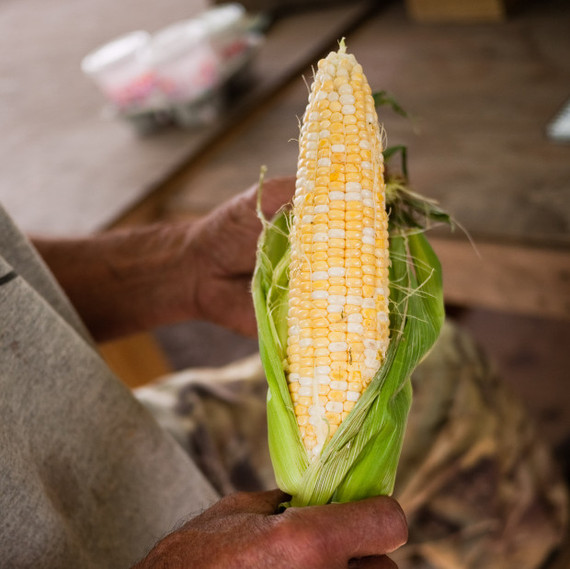
We're deep in the heart of corn season, with piles of bright-green ears stacked on tables at farmers markets and supermarkets across much of the country. But next time you go shopping for a dozen (which, if you're anything like us, is probably in the next 24 hours), pay close attention to how the corn is being sold. Is it called "bicolor" or "Butter and Sugar"? Is it branded as "white corn" or "Silver Queen"? Is it "native corn"? Or is it just plain yellow corn on the cob?
Once you've taken note of those names, then I want you to think about apples. (Bear with me here!) Apples can be crisp or soft, tart or sweet, large or small, thick-skinned or thin-skinned, and the names of those apples -- Macoun, Honey Crisp, McIntosh, Fuji, Gala, and so on -- correspond to a particular set of those characteristics.
Not so with corn. Silver Queen may be all-white, but are the kernels big or small? Is Butter and Sugar particularly buttery and sweet? Well, yes and no. No and yes. And really: maybe! Who knows?
Once upon a time, at the dawn of the era of commercial sweet-corn farming in the late 1950s and early 1960s, the names did have fixed, specific meanings. Take Silver Queen, found mostly from the mid-Atlantic region up through New England. It was, according to Joe Waskiewicz, the 85-year-old proprietor of the century-old J&J Farms, in Amherst, Massachusetts, "always a very sweet corn." Awesome. Then, 50-60 years ago, agricultural scientists at the University of Massachusetts began developing new bicolor varieties, attempting to incorporate "some of that sweetness," Waskiewicz surmised, into a blended yellow-white variety.
The result was the first official Butter and Sugar corn variety, and it was a hit. With a name like that, how could it not be? Even today, farm stands will label their bicolor corn as "Butter and Sugar." Thing is, it may not be that '50s-vintage variety at all.
For evidence, simply look through the bicolor-sweet-corn section of seed catalog Harris Seeds. There are dozens of varieties listed, from Allure to Cameo to Revelation. But there is no Butter and Sugar. Five decades after it was developed, the original Butter and Sugar has been superseded by other, newer categories of corn, such as Sugary Enhanced Bicolors and Synergistic Bicolors, all of which were developed to increase and preserve the sweetness and tenderness of the kernels.
So why don't farmers and markets brand their corn according to the contemporary seed names? Well, some do. In recent years, I've seen Mirai, Applause, and even Bon Appetit varieties for sale at farmstands. But those were outliers. Most farmers shy away from such names for two reasons, I suspect:
1. To them, the seed names often have more to do with how the corn grows than how it tastes. The Harris writeup for Applause, for example, details how long the corn takes to mature (75 days), its hardiness ("intermediate resistance to Stewart's wilt"), and the number of rows (16). Yes, the kernels are "very tender and very sweet," and the "8 in. ears" are described as "classy," but that could probably be said of many varieties. Only occasionally do you get a writeup like this one:
"Mr. Mini Mirai offers truly exceptional sweetness, deep kernels, and petite ears that fit on a dinner plate. We sampled this gourmet quality corn to local chefs, and they raved about its outstanding flavor, tenderness, and classy appearance."
Note to farmers (and, I guess, Whole Foods): That's the kind of branding and writing that would sell me on a dozen ears.
2. "Allure" doesn't quite have the allure of "Butter and Sugar," and "Silver King" is no "Silver Queen." This is simple psychology: Why bother explaining to consumers what Powwow is when you can just rely on good old (and perfectly branded) Butter and Sugar? I get it, but we're living in an ear era when customers, especially those who shop at farmers' markets, are incredibly curious about the products available. They want to know how Harris Seed describes the variety, and maybe even be willing to learn about maturation times and disease-resistance. All it takes is a savvy marketer to get us hooked on Providence.
Well, a savvy marketer -- and a very good farmer. A couple of weeks ago, when I discovered the Bon Appetit ears at a farmstand in Concord, Massachusetts, I was, understandably, out-of-my-mind excited to try them. I brought them back to my parents' place, where we boiled them briefly, slathered them with butter and salt, and began furiously to eat. They... were... okay. Harris Seeds describes them as having "great corn flavor and tenderness" and being "significantly sweeter ... than most other sugary enhanced types." Yeah, well. They were fine. I think I ate one ear.
After that, my family and I switched back to our favorite farm for corn: Hutchins Farm. There the kernels are always sweet, always tender, and all organic. But what specific variety of corn do they grow? I have absolutely no idea -- and when I've got a platter of steaming ears in front of me, I'm not sure I care.
